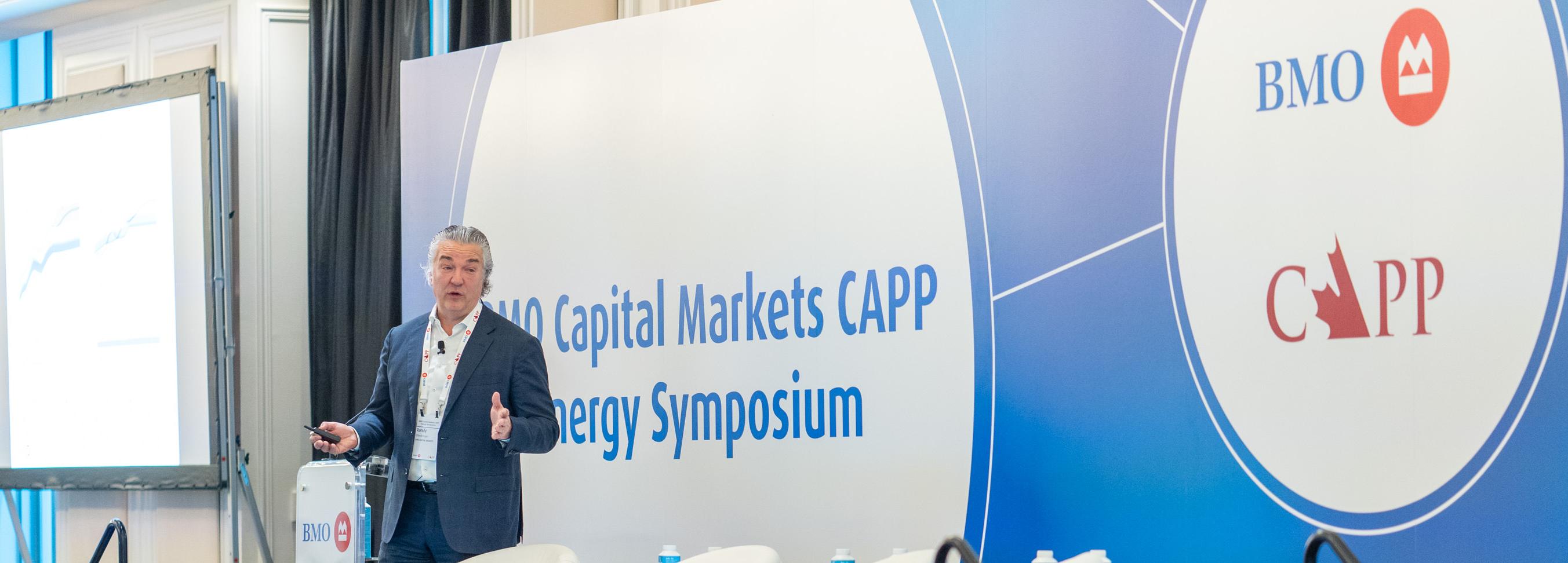
Outlook for Western Canadian Gas
-
bookmark
-
print
Western Canadian natural gas producers expect to see an increase in demand in the latter half of the year on the back of a project coming online in months. The LNG Canada project is a significant liquified natural gas plant and pipeline emanating from Kitimat, British Columbia.
The facility will allow Western Canadian producers to reach global markets such as Asia, where there is significant demand for natural gas. This is one reason why BMO sees room for valuations to increase in the sector, particularly as supply gets incrementally tighter over the course of the year and into 2025. The positive outlook is a welcome change, but producers will still have to navigate a series of challenges that could constrain their output.
Understanding the market forces at play was the focus of the “Outlook for Western Canadian Gas” panel that I recently hosted in Toronto at the BMO Capital Markets CAPP Energy Symposium, featuring:
-
Jamie Heard, Vice President of Capital Markets, Tourmaline Oil Corp.
-
Chris Carlsen, President and CEO, Birchcliff Energy
-
Jean-Paul Lachance, President and CEO, Peyto Exploration & Development Corp.
Outlook for natural gas
“There’s certainly some pessimistic views on the summer gas price, which we’ll need to get through first,” said Birchcliff’s Chris Carlsen. However, he says the LNG Canada project and a potential increase in demand for power generation in Alberta are encouraging for the sector. With that pick-up still several months away, Birchcliff is deferring some of its capital spending to the second half of the year to ensure any new production can capitalize on higher demand.
Peyto’s Jean-Paul Lachance estimates that LNG Canada will represent 10% of Western Canadian gas once the facility comes on stream. “That’s material,” he said. “Anytime you can put up a market into tension like that, it’s going to be good for the market.” LNG Canada may not have an immediate impact on Peyto’s current output, but it will be constructive to the basin's egress capacity.
What’s more, the development of LNG Canada is important to Western Canadian producers, but other new LNG facilities in the U.S. and Canada can also affect this sector.
As important as it is for the sector to have a global footprint, Tourmaline’s Jamie Heard is also encouraged by the potential for higher demand in North America, with the growing use of heat pumps, electric vehicles and data servers. “In our view, I would agree, we will continue to see weak cash pricing both locally and in the U.S. firming through the summer, and then more rapidly in the fall,” he said.
Expanding LNG
In Canada, other liquified natural gas projects are also in the works. Rockies LNG, a partnership of Western Canadian natural gas producers looking to develop LNG export opportunities, can also change the landscape.
The way these LNG projects are being developed is noteworthy. In the case of Rockies LNG, the project leads have partnered with the Nisga'a Nation, which owns the traditional territory where the floating LNG facility will be located. Nisga’a Nation also has an ownership stake in the project, which is helping the project gain traction and reach new milestones.
“Our partners in Ksi Lisims have a pipeline that’s permitted all the way to the West Coast,” said Carlsen. The project already has an offtake agreement, and it’s working on others. “From a producer point of view, it’s the access to global markets that we’re really after for Canadian producers,” he said.
Constraints on supply
As much as natural gas producers want to get their products to market, there are limitations. As Carlsen explains, finding capacity on the TransCanada Pipelines can take up to four years due to the consultation periods, system modeling, and regulatory process. “All those have added up,” he said, noting that wait time is almost double what it was many years ago.
Finding skilled workers is another challenge that affects all energy produced in Western Canada, causing companies like Birchcliff to carefully pick which projects to develop.
Nevertheless, Birchcliff’s Chris Carlsen is looking forward to a second-half pick-up in energy demand this year. “We see some real positives in terms of the demand-pull that’s coming,” he said.

Outlook for Western Canadian Gas
Oil & Gas Producers Analyst BMO Nesbitt Burns Inc.
Randy leads BMO Capital Markets’ coverage of the North American oil and gas industry, covering the Canadian integrateds, large cap oil & gas producers and…
Randy leads BMO Capital Markets’ coverage of the North American oil and gas industry, covering the Canadian integrateds, large cap oil & gas producers and…
VIEW FULL PROFILE-
Minute Read
-
Listen
Stop
-
Text Bigger | Text Smaller
Western Canadian natural gas producers expect to see an increase in demand in the latter half of the year on the back of a project coming online in months. The LNG Canada project is a significant liquified natural gas plant and pipeline emanating from Kitimat, British Columbia.
The facility will allow Western Canadian producers to reach global markets such as Asia, where there is significant demand for natural gas. This is one reason why BMO sees room for valuations to increase in the sector, particularly as supply gets incrementally tighter over the course of the year and into 2025. The positive outlook is a welcome change, but producers will still have to navigate a series of challenges that could constrain their output.
Understanding the market forces at play was the focus of the “Outlook for Western Canadian Gas” panel that I recently hosted in Toronto at the BMO Capital Markets CAPP Energy Symposium, featuring:
-
Jamie Heard, Vice President of Capital Markets, Tourmaline Oil Corp.
-
Chris Carlsen, President and CEO, Birchcliff Energy
-
Jean-Paul Lachance, President and CEO, Peyto Exploration & Development Corp.
Outlook for natural gas
“There’s certainly some pessimistic views on the summer gas price, which we’ll need to get through first,” said Birchcliff’s Chris Carlsen. However, he says the LNG Canada project and a potential increase in demand for power generation in Alberta are encouraging for the sector. With that pick-up still several months away, Birchcliff is deferring some of its capital spending to the second half of the year to ensure any new production can capitalize on higher demand.
Peyto’s Jean-Paul Lachance estimates that LNG Canada will represent 10% of Western Canadian gas once the facility comes on stream. “That’s material,” he said. “Anytime you can put up a market into tension like that, it’s going to be good for the market.” LNG Canada may not have an immediate impact on Peyto’s current output, but it will be constructive to the basin's egress capacity.
What’s more, the development of LNG Canada is important to Western Canadian producers, but other new LNG facilities in the U.S. and Canada can also affect this sector.
As important as it is for the sector to have a global footprint, Tourmaline’s Jamie Heard is also encouraged by the potential for higher demand in North America, with the growing use of heat pumps, electric vehicles and data servers. “In our view, I would agree, we will continue to see weak cash pricing both locally and in the U.S. firming through the summer, and then more rapidly in the fall,” he said.
Expanding LNG
In Canada, other liquified natural gas projects are also in the works. Rockies LNG, a partnership of Western Canadian natural gas producers looking to develop LNG export opportunities, can also change the landscape.
The way these LNG projects are being developed is noteworthy. In the case of Rockies LNG, the project leads have partnered with the Nisga'a Nation, which owns the traditional territory where the floating LNG facility will be located. Nisga’a Nation also has an ownership stake in the project, which is helping the project gain traction and reach new milestones.
“Our partners in Ksi Lisims have a pipeline that’s permitted all the way to the West Coast,” said Carlsen. The project already has an offtake agreement, and it’s working on others. “From a producer point of view, it’s the access to global markets that we’re really after for Canadian producers,” he said.
Constraints on supply
As much as natural gas producers want to get their products to market, there are limitations. As Carlsen explains, finding capacity on the TransCanada Pipelines can take up to four years due to the consultation periods, system modeling, and regulatory process. “All those have added up,” he said, noting that wait time is almost double what it was many years ago.
Finding skilled workers is another challenge that affects all energy produced in Western Canada, causing companies like Birchcliff to carefully pick which projects to develop.
Nevertheless, Birchcliff’s Chris Carlsen is looking forward to a second-half pick-up in energy demand this year. “We see some real positives in terms of the demand-pull that’s coming,” he said.
BMO Capital Markets CAPP Energy Symposium
PART 1
Canada's Energy Sector Balances Growth and Shareholder Returns
Jeremy McCrea April 19, 2024
Companies in the Canadian energy sector have been focused on streamlining operations and lowering greenhouse gas emissions to stay competitive with…
PART 2
Attracting More Generalist Investors in North America to the Oil and Gas Industry
Jeremy McCrea April 19, 2024
Oil and gas companies have recently managed to court some interest from generalist investors, such as pension funds and broad-based mutual …
You might also be interested in
IN Tune: The AI + Data Center Build Out: Sustainability Impacts, Second Order Beneficiaries
Food, Ag, Fertilizer, and ESG From BMO’s 19th Annual Farm to Market Conference: BMO Equity Research
IN Tune: Food, Ag, Fertilizer, and ESG From BMO’s 19th Annual Farm to Market Conference
IN Tune: Investment Ideas for Climate Change: Discussing the BMO Climate Opportunities Screen
Federal Budget 2024: Capital Gains Taxes Climb; Some Nuggets for Entrepreneurs
Inaugural BMO Obesity Summit Focuses on Therapeutics and Combating a Growing Epidemic

Women are Leading Across the Landscape of Climate and Sustainability
Canada Has an Opportunity to Become a Global Leader in Carbon Dioxide Removal

Extreme Temperatures: How North American Cities Amplify Climate Change
Three Keys to Unlocking Energy Transition: Partnerships, Permitting, and Finance
BMO Blue Book: U.S. Economy is Resilient but Predicted to Slow in Early 2024
How the Energy Sector Is Helping Canada Achieve Its Decarbonization Goals
The Age of Transparency: Companies Poised to Benefit as Reporting Rules Tighten
Breaking Down the Food Waste Problem: Big Inefficiencies = Big Opportunity
ESG Thoughts of the Week from BMO Equity Research: Wildfire Risk, CAT Losses Increasing

Quick Listen: Darryl White on the Importance of US-Canada Partnership

Food, Ag, Fertilizer, and ESG From BMO’s 18th Annual Farm to Market Conference
Driving Innovations In Tech To Strengthen Climate Resilience With Climate Engine’s Spatiafi, Built On Google Cloud
North American Agriculture’s Role in Meeting the Global Food Insecurity Challenge – US-Canada Summit
Energy Transition Will Require Collaboration Between Miners and End-Users
Not All Carbon Credits Created Equal: BMO Global Metals, Mining & Critical Minerals Conference
Will 2023 be the Year of Gold: World Gold Council at BMO Conference
Is Green Financing for Nuclear the Next Frontier in the Energy Transition?
Top Rankings for BMO Capital Markets' FICC Macro Strategy Group in Institutional Investor Client Survey
The Market Transition from COVID-19 has Begun: Belski to BMO Metals and Mining Conference












